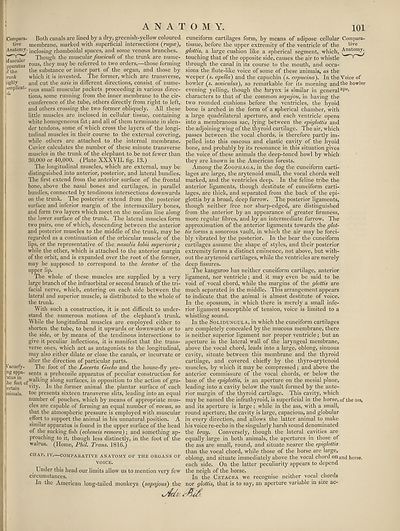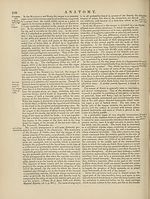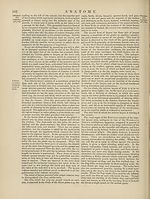Encyclopaedia Britannica > Volume 3, Anatomy-Astronomy
(109) Page 101
Download files
Complete book:
Individual page:
Thumbnail gallery: Grid view | List view

*
ANATOMY. 101
Compara- Both canals are lined by a dry, greenish-yellow coloured
t*ve membrane, marked with superficial intersections (rugce),
Anatomy. incios;ng rhomboidal spaces, and some venous branches.
'TV Though the muscular fasciculi of the trunk are nume-
nnaratus rous’ they may be referred to two orders,—those forming
,[• the the substance or inner part of the organ, and those by
runk which it is invested. The former, which are transverse,
lighly and cut the axis in different directions, consist of nume-
omplicat- roug sma]i mUscular packets proceeding in various direc¬
tions, some running from the inner membrane to the cir¬
cumference of the tube, others directly from right to left,
and others crossing the two former obliquely. All these
little muscles are inclosed in cellular tissue, containing
white homogeneous fat; and all of them terminate in slen¬
der tendons, some of which cross the layers of the longi¬
tudinal muscles in their course to the external covering,
while others are attached to the internal membrane.
Cuvier calculates the number of these minute transverse
muscles in the trunk of the elephant to be not fewer than
30,000 or 40,000. (Plate XXXVII. fig. 13.)
The longitudinal muscles, which are external, may be
distinguished into anterior, posterior, and lateral bundles.
The first extend from the anterior surface of the frontal
bone, above the nasal bones and cartilages, in parallel
bundles, connected by tendinous intersections downwards
on the trunk. The posterior extend from the posterior
surface and inferior margin of the intermaxillary bones,
and form two layers which meet on the median line along
the lower surface of the trunk. The lateral muscles form
two pairs, one of which, descending between the anterior
and posterior muscles to the middle of the trunk, may be
regarded as a continuation of the orbicular muscle of the
lips, or the representative of the nasalis labii superioris ;
while the other, which is attached to the anterior margin
of the orbit, and is expanded over the root of the former,
may be supposed to correspond to the levator of the
upper lip.
The whole of these muscles are supplied by a very
large branch of the infraorbital or second branch of the tri¬
facial nerve, which, entering on each side between the
lateral and superior muscle, is distributed to the whole of
the trunk.
With such a construction, it is not difficult to under¬
stand the numerous motions of the elephant’s trunk.
While the longitudinal muscles are employed either to
shorten the tube, to bend it upwards or downwards or to
the side, or by means of the tendinous intersections to
give it peculiar inflections, it is manifest that the trans¬
verse ones, which act as antagonists to the longitudinal,
may also either dilate or close the canals, or incurvate or
alter the direction of particular parts.
^acuefy- The foot of the Lacerta Gecko and the house-fly pre-
ng appa- sents a prehensile apparatus of peculiar construction for
heUfeet 0fW.alking alonS surf'aces, n opposition to the action of gra-
ertain v^y* In the former animal the plantar surface of each
mimals. toe presents sixteen transverse slits, leading into an equal
number of pouches, which by means of appropriate mus¬
cles are capable of forming an equal number of vacua, so
that the atmospheric pressure is employed with muscular
effort to support the animal in his unnatural position. A
similar apparatus is found in the upper surface of the head
of the sucking fish (echeneis remora); and something ap¬
proaching to it, though less distinctly, in the foot of the
walrus. (Home, Phil. Trans. 1816.)
CHAP. XV.—COMPAKATIVE ANATOMY OF THE ORGANS OF
VOICE.
„ Under this head our limits allow us to mention very few
circumstances.
In the American long-tailed monkeys (sapajous') the
Mv.
cuneiform cartilages form, by means of adipose cellular Compara-
tissue, before the upper extremity of the ventricle of the ^ve
glottis, a large cushion like a spherical segment, which, Anatomy,
touching that of the opposite side, causes the air to whistle
through the canal in its course to the mouth, and occa¬
sions the flute-like voice of some of these animals, as the
weeper (s. apella) and the capuchin (s. capucina). In the Voice of
howler («. seniculus), so remarkable for its morning and the howler
evening yelling, though the larynx is similar in general aPe>
characters to that of the common sapajou, in having the
two rounded cushions before the ventricles, the hyoid
bone is arched in the form of a spherical chamber, with
a large quadrilateral aperture, and each ventricle opens
into a membranous sac, lying between the epiglottis and
the adjoining wing of the thyroid cartilage. The air, which
passes between the vocal chords, is therefore partly im¬
pelled into this osseous and elastic cavity of the hyoid
bone, and probably by its resonance in this situation gives
the voice of these animals the deep-toned howl by which
they are known in the American forests.
Among the Zoophaga, in the dog the cuneiform carti¬
lages are large, the arytenoid small, the vocal chords well
marked, and the ventricles deep. In the feline tribe the
anterior ligaments, though destitute of cuneiform carti¬
lages, are thick, and separated from the back of the epi¬
glottis by a broad, deep furrow. The posterior ligaments,
though neither free nor sharp-edged, are distinguished
from the anterior by an appearance of greater firmness,
more regular fibres, and by an intermediate furrow. The
approximation of the anterior ligaments towards the glot¬
tis forms a sonorous vault, in which the air may be forci¬
bly vibrated by the posterior. In the bear the cuneiform
cartilages assume the shape of styles, and their posterior
extremity forms a distinct eminence, not above, but with¬
out the arytenoid cartilages, while the ventricles are merely
deep fissures.
The kangaroo has neither cuneiform cartilage, anterior
ligament, nor ventricle; and it may even be said to be
void of vocal chord, while the margins of the glottis are
much separated in the middle. This arrangement appears
to indicate that the animal is almost destitute of voice.
In the opossum, in which there is merely a small infe¬
rior ligament susceptible of tension, voice is limited to a
whistling sound.
In the Solidungula, in which the cuneiform cartilages
are completely concealed by the mucous membrane, there
is neither superior ligament nor proper ventricle; but an
aperture in the lateral wall of the laryngeal membrane,
above the vocal chord, leads into a large, oblong, sinuous
cavity, situate between this membrane and the thyroid
cartilage, and covered chiefly by the thyro-arytenoid
muscles, by which it may be compressed; and above the
anterior commissure of the vocal chords, or below the
base of the epiglottis, is an aperture on the mesial plane,
leading into a cavity below the vault formed by the ante¬
rior margin of the thyroid cartilage. This cavity, which
maybe named the infrathyroid, is superficial in the horse, of the ass,
and its aperture is large; while in the ass, with a small,
round aperture, the cavity is large, capacious, and globular
in every direction, and allows the latter animal to make
his voice re-echo in the singularly harsh sound denominated
the brag. Conversely, though the lateral cavities are
equally large in both animals, the apertures in those of
the ass are small, round, and situate nearer the epiglottis
than the vocal chord, while those of the horse are large,
oblong, and situate immediately above the vocal chord on and horse,
each side. On the latter peculiarity appears to depend
the neigh of the horse.
In the Cetacea we recognise neither vocal chords
nor glottis, that is to say, an aperture variable in size ac-
ANATOMY. 101
Compara- Both canals are lined by a dry, greenish-yellow coloured
t*ve membrane, marked with superficial intersections (rugce),
Anatomy. incios;ng rhomboidal spaces, and some venous branches.
'TV Though the muscular fasciculi of the trunk are nume-
nnaratus rous’ they may be referred to two orders,—those forming
,[• the the substance or inner part of the organ, and those by
runk which it is invested. The former, which are transverse,
lighly and cut the axis in different directions, consist of nume-
omplicat- roug sma]i mUscular packets proceeding in various direc¬
tions, some running from the inner membrane to the cir¬
cumference of the tube, others directly from right to left,
and others crossing the two former obliquely. All these
little muscles are inclosed in cellular tissue, containing
white homogeneous fat; and all of them terminate in slen¬
der tendons, some of which cross the layers of the longi¬
tudinal muscles in their course to the external covering,
while others are attached to the internal membrane.
Cuvier calculates the number of these minute transverse
muscles in the trunk of the elephant to be not fewer than
30,000 or 40,000. (Plate XXXVII. fig. 13.)
The longitudinal muscles, which are external, may be
distinguished into anterior, posterior, and lateral bundles.
The first extend from the anterior surface of the frontal
bone, above the nasal bones and cartilages, in parallel
bundles, connected by tendinous intersections downwards
on the trunk. The posterior extend from the posterior
surface and inferior margin of the intermaxillary bones,
and form two layers which meet on the median line along
the lower surface of the trunk. The lateral muscles form
two pairs, one of which, descending between the anterior
and posterior muscles to the middle of the trunk, may be
regarded as a continuation of the orbicular muscle of the
lips, or the representative of the nasalis labii superioris ;
while the other, which is attached to the anterior margin
of the orbit, and is expanded over the root of the former,
may be supposed to correspond to the levator of the
upper lip.
The whole of these muscles are supplied by a very
large branch of the infraorbital or second branch of the tri¬
facial nerve, which, entering on each side between the
lateral and superior muscle, is distributed to the whole of
the trunk.
With such a construction, it is not difficult to under¬
stand the numerous motions of the elephant’s trunk.
While the longitudinal muscles are employed either to
shorten the tube, to bend it upwards or downwards or to
the side, or by means of the tendinous intersections to
give it peculiar inflections, it is manifest that the trans¬
verse ones, which act as antagonists to the longitudinal,
may also either dilate or close the canals, or incurvate or
alter the direction of particular parts.
^acuefy- The foot of the Lacerta Gecko and the house-fly pre-
ng appa- sents a prehensile apparatus of peculiar construction for
heUfeet 0fW.alking alonS surf'aces, n opposition to the action of gra-
ertain v^y* In the former animal the plantar surface of each
mimals. toe presents sixteen transverse slits, leading into an equal
number of pouches, which by means of appropriate mus¬
cles are capable of forming an equal number of vacua, so
that the atmospheric pressure is employed with muscular
effort to support the animal in his unnatural position. A
similar apparatus is found in the upper surface of the head
of the sucking fish (echeneis remora); and something ap¬
proaching to it, though less distinctly, in the foot of the
walrus. (Home, Phil. Trans. 1816.)
CHAP. XV.—COMPAKATIVE ANATOMY OF THE ORGANS OF
VOICE.
„ Under this head our limits allow us to mention very few
circumstances.
In the American long-tailed monkeys (sapajous') the
Mv.
cuneiform cartilages form, by means of adipose cellular Compara-
tissue, before the upper extremity of the ventricle of the ^ve
glottis, a large cushion like a spherical segment, which, Anatomy,
touching that of the opposite side, causes the air to whistle
through the canal in its course to the mouth, and occa¬
sions the flute-like voice of some of these animals, as the
weeper (s. apella) and the capuchin (s. capucina). In the Voice of
howler («. seniculus), so remarkable for its morning and the howler
evening yelling, though the larynx is similar in general aPe>
characters to that of the common sapajou, in having the
two rounded cushions before the ventricles, the hyoid
bone is arched in the form of a spherical chamber, with
a large quadrilateral aperture, and each ventricle opens
into a membranous sac, lying between the epiglottis and
the adjoining wing of the thyroid cartilage. The air, which
passes between the vocal chords, is therefore partly im¬
pelled into this osseous and elastic cavity of the hyoid
bone, and probably by its resonance in this situation gives
the voice of these animals the deep-toned howl by which
they are known in the American forests.
Among the Zoophaga, in the dog the cuneiform carti¬
lages are large, the arytenoid small, the vocal chords well
marked, and the ventricles deep. In the feline tribe the
anterior ligaments, though destitute of cuneiform carti¬
lages, are thick, and separated from the back of the epi¬
glottis by a broad, deep furrow. The posterior ligaments,
though neither free nor sharp-edged, are distinguished
from the anterior by an appearance of greater firmness,
more regular fibres, and by an intermediate furrow. The
approximation of the anterior ligaments towards the glot¬
tis forms a sonorous vault, in which the air may be forci¬
bly vibrated by the posterior. In the bear the cuneiform
cartilages assume the shape of styles, and their posterior
extremity forms a distinct eminence, not above, but with¬
out the arytenoid cartilages, while the ventricles are merely
deep fissures.
The kangaroo has neither cuneiform cartilage, anterior
ligament, nor ventricle; and it may even be said to be
void of vocal chord, while the margins of the glottis are
much separated in the middle. This arrangement appears
to indicate that the animal is almost destitute of voice.
In the opossum, in which there is merely a small infe¬
rior ligament susceptible of tension, voice is limited to a
whistling sound.
In the Solidungula, in which the cuneiform cartilages
are completely concealed by the mucous membrane, there
is neither superior ligament nor proper ventricle; but an
aperture in the lateral wall of the laryngeal membrane,
above the vocal chord, leads into a large, oblong, sinuous
cavity, situate between this membrane and the thyroid
cartilage, and covered chiefly by the thyro-arytenoid
muscles, by which it may be compressed; and above the
anterior commissure of the vocal chords, or below the
base of the epiglottis, is an aperture on the mesial plane,
leading into a cavity below the vault formed by the ante¬
rior margin of the thyroid cartilage. This cavity, which
maybe named the infrathyroid, is superficial in the horse, of the ass,
and its aperture is large; while in the ass, with a small,
round aperture, the cavity is large, capacious, and globular
in every direction, and allows the latter animal to make
his voice re-echo in the singularly harsh sound denominated
the brag. Conversely, though the lateral cavities are
equally large in both animals, the apertures in those of
the ass are small, round, and situate nearer the epiglottis
than the vocal chord, while those of the horse are large,
oblong, and situate immediately above the vocal chord on and horse,
each side. On the latter peculiarity appears to depend
the neigh of the horse.
In the Cetacea we recognise neither vocal chords
nor glottis, that is to say, an aperture variable in size ac-
Set display mode to:
![]() Universal Viewer |
Universal Viewer | ![]() Mirador |
Large image | Transcription
Mirador |
Large image | Transcription
Images and transcriptions on this page, including medium image downloads, may be used under the Creative Commons Attribution 4.0 International Licence unless otherwise stated. ![]()
| Encyclopaedia Britannica > Encyclopaedia Britannica > Volume 3, Anatomy-Astronomy > (109) Page 101 |
|---|
| Permanent URL | https://digital.nls.uk/193758765 |
|---|
| Attribution and copyright: |
|
|---|---|
| Shelfmark | EB.16 |
|---|---|
| Description | Ten editions of 'Encyclopaedia Britannica', issued from 1768-1903, in 231 volumes. Originally issued in 100 weekly parts (3 volumes) between 1768 and 1771 by publishers: Colin Macfarquhar and Andrew Bell (Edinburgh); editor: William Smellie: engraver: Andrew Bell. Expanded editions in the 19th century featured more volumes and contributions from leading experts in their fields. Managed and published in Edinburgh up to the 9th edition (25 volumes, from 1875-1889); the 10th edition (1902-1903) re-issued the 9th edition, with 11 supplementary volumes. |
|---|---|
| Additional NLS resources: |
|

